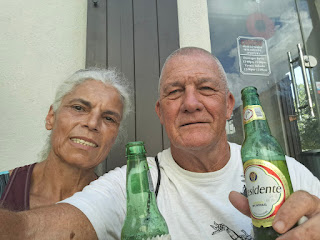Sugar cane fields on our way to Santo Domingo, the capital of the Dominican Republic.
In 1501, the Spanish monarchs, Ferdinand I and Isabella, first granted permission to the colonists of the Caribbean to import African slaves, who began arriving to the island in 1503. In 1510, the first sizable shipment, consisting of 250 Black Ladinos, arrived in Hispaniola from Spain. Eight years later African-born slaves arrived in the West Indies (called the West Indies as when Columbus first arrived, he thought he had reached India). The Colony of Santo Domingo was organized as the Royal Audiencia of Santo Domingo in 1511. Sugar cane was introduced to Hispaniola from the Canary Islands, and the first sugar mill in the New World was established in 1516, on Hispaniola. The need for a labor force to meet the growing demands of sugar cane cultivation led to an exponential increase in the importation of slaves over the following two decades. The sugar mill owners soon formed a new colonial elite and convinced the Spanish king to allow them to elect the members of the Real Audiencia from their ranks. Poorer colonists subsisted by hunting the herds of wild cattle that roamed throughout the island and selling their hides.
The first major slave revolt in the Americas occurred in Santo Domingo on December 25, 1521, when enslaved Muslims of the Wolof nation led an uprising in the sugar plantation of admiral Don Diego Colon, son of Christopher Columbus. Many of these insurgents managed to escape to the mountains where they formed independent maroon communities, but the Admiral had a lot of the captured rebels hanged.
Arch on the entrance to the The Colonial Zone which is both an important historical site and a vibrant neighborhood.
Founded in 1498, the Santo Domingo Colonial Zone is the oldest European settlement in the New World. In 1990, the entire zone was listed as a UNESCO World Heritage Site.
The Colonial Zone is a wonderland of historic Spanish Colonial buildings and monuments. Yet, the area is so much more than a mere open-air museum. It is a bustling district filled with shops, restaurants, cafes and night clubs. The vibrant street life, incredible live music performances and beautiful parks and squares make the Colonial Zone a prime tourist destination.
A towering monument dedicated to Christopher Columbus. It’s called “Faro a Colon”, which is Spanish for “Columbus Lighthouse”, so named because of its powerful lighting system consisting up nearly 150 searchlight beams that project a gigantic cross in the sky. The beams are so powerful that they can be seen as far away as Puerto Rico. Unfortunately, when the 70-kilowatt beams are turned on it causes a power blackout in the immediate neighborhood, which is why they are rarely switched on.
There is another thing that makes Faro a Colon a special attraction: it is purported to contain the remains of Christopher Columbus, a claim that is, however, challenged by the Cathedral of Seville, in Spain.
Getting off the cruise ship, La Romana, in the Dominican Republic
Parque Colon itself takes up the whole block and is a great place to sit and watch the world go by. You will see many interesting characters go by – well worth a visit. Here you will find the Cathedral Primada de America – the first Cathedral in the new world. Originally it was built in 1514 however there have been many additions and changes since then. The first stone was laid by Diego Columbus – the brother of Christopher Columbus. It is beautiful inside and is definitely a must see.
Our guide showing us the large area that is the Dominican republic.
The islands of the Caribbean were first settled around 6,000 years ago by hunter-gatherer peoples originating from Central America or northern South America. The Arawakan-speaking ancestors of the Taíno moved into the Caribbean from South America during the 1st millennium BC, reaching Hispaniola by around 600 AD. These Arawakan peoples engaged in farming, fishing, hunting and gathering, and the widespread production of ceramic goods. The estimates of Hispaniola's population in 1492 vary widely, including tens of thousands. Estimating how many people lived on the island in pre-Columbian times is challenging, as no accurate records exist. At the time of Columbus' arrival in 1492, the island's territory consisted of five Taíno chiefdoms: Marién, Maguá, Maguana, Jaragua, and Higüey. These were ruled respectively by caciques Guacanagarix, Guarionex, Caonabo, Bohechío, and Cayacoa. The Taíno name for the entire island was either Ayiti (land of high mountains) or Quisqueya (mother of all lands).
First place we stopped at to go to the bathroom












No comments:
Post a Comment